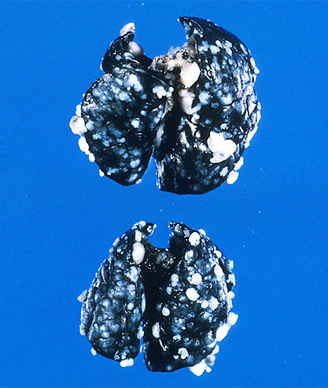Antioxidants Increase Lung Tumor Progression in Mice
A study in mice showed that antioxidant supplementation increases tumor progression and reduced survival in Braf- and Kras-induced lung cancer.
Mice lungs showing metastases.

A study in mice showed that antioxidant supplementation increases tumor progression and reduced survival in Braf- and Kras-induced lung cancer. Though the study was only an animal model, researchers say that it does hold relevance and the effect is likely also seen in human patients. The results of the study were published in Science Translational Medicine.
“Popular wisdom-supported by numerous cellular and preclinical studies-holds that antioxidants protect against cancer,” wrote researchers led by Martin O. Bergö, PhD, of the Sahlgrenska Cancer Center in Gothenburg, Sweden. “However, large randomized clinical trials have produced inconsistent results, and some studies indicate that antioxidants may even increase cancer risk.” In the new study, the researchers tested antioxidant supplementation in mice with certain types of lung cancer.
The mice, with Kras-induced or Braf-induced lung cancer, were given two antioxidants: N-acetylcysteine (NAC) and vitamin E, which are structurally unrelated. In mice that received NAC, 10 weeks after tumor initiation they were found to have a 2.8-fold higher tumor burden than control mice that did not receive the antioxidant. Vitamin E also increased tumor burden in a separate set of mice, in a dose-dependent fashion.
Furthermore, NAC and vitamin E appear to have various molecular effects that aid in that tumor progression. The antioxidants “markedly reduced” the amounts of p53, a tumor suppressor that regulates cell proliferation; this is particularly relevant because somatic mutations in p53 generally occur late in tumor progressions, and thus antioxidants commonly given to smokers and those with pulmonary disease could be accelerating the early growth of cancerous lesions.
NAC and vitamin E also increased the proliferation of oncogene-expressing fibroblasts, and reduced the damage from reactive oxygen species (ROS) that can limit tumor cell proliferation. The authors wrote that the simplest explanation for this could be that a feedback mechanism in lung cells “downregulates the endogenous ROS defense system” when the antioxidants act to reduce the amounts of expressed ROS.
Bergö said in an e-mail that though these data are in mice only, they in fact can be extrapolated to a great degree to humans with lung cancer. “The mouse tumors are similar in appearance to human tumors,” he said. “We see the same effect in human lung tumor cells, and several human clinical trials have shown increased cancer in antioxidant-treated groups. So we believe this has direct relevance to human cancer.”